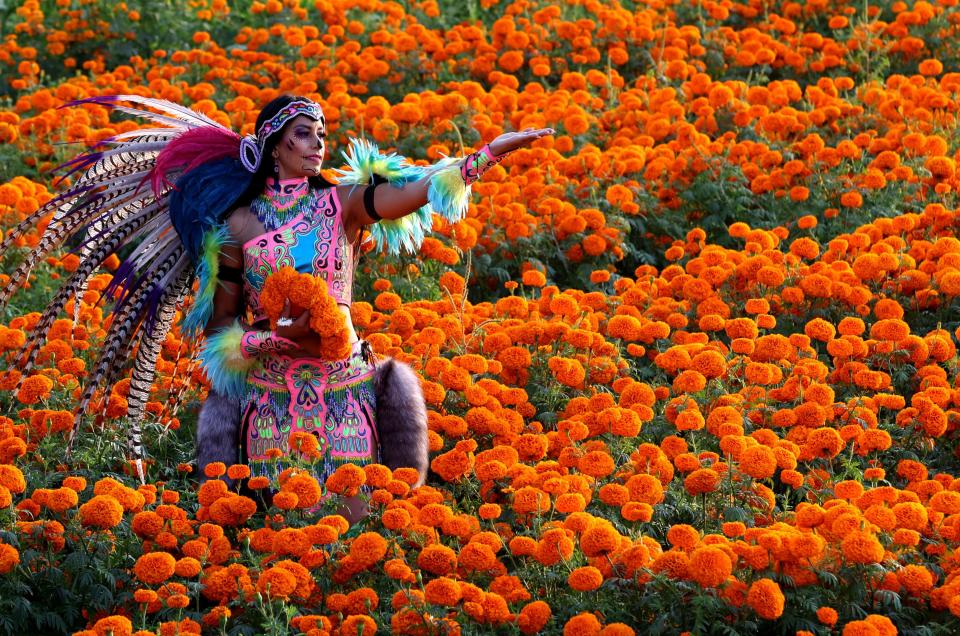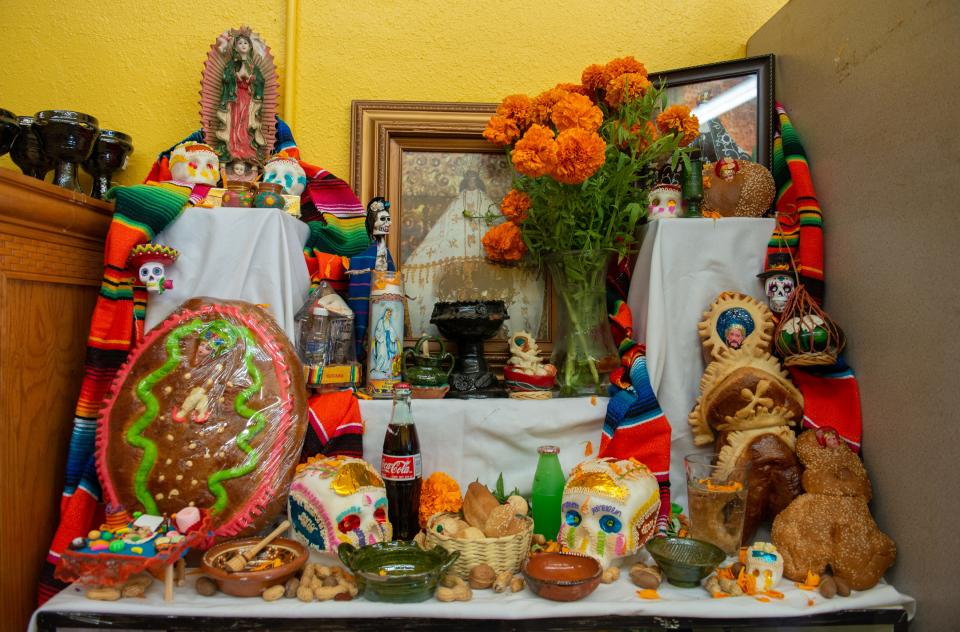Marigolds, or cempazúchitl, adorn Día de los Muertos altars: How Salinas is celebrating
As fall temperatures drop in Salinas, the crinkly orange and yellow petals of cempazúchitl, or marigold, begin to brightly appear at markets, in the buckets of street flower vendors, and atop ofrendas, or altars, throughout Salinas homes, businesses, and community buildings.
For Salinas artist José G. Ortiz, the flower’s scent is unifying as a way to remember the dead.
“It’s like no other flower,” he said. “The scent brings back memories. You remember the person and their favorite song, favorite food, favorite flower, everything.”
The distinctive aroma of the flor de muerto, or flower of the dead, is said to help guide the dead back to altars during the Mexican celebration of Dia de los Muertos, and in Mexico, some residents build paths with the flowers from a home’s main road all the way to the altar inside.
Today, the flower symbolizes Día de los Muertos in Mexico and is often used to create floral arches, garlands and symbols on the altars, which are also decorated with photos of the dead, food, drinks, candles, sugar skulls, pan de muerto, papel picado, or paper banners, and more.

Ortiz keeps an ofrenda in his home year round and said it’s as if, “you’re inviting someone that meant so much to you and you’re bringing them back for dinner.”
Ortiz is founding director of Hijos del Sol Arts Productions, a nonprofit art organization, which for years has created a collection of ofrendas for the community.
He clearly remembers how his family - of the Tepehuanes, or mountain people, in Durango, Mexico - used cempazúchitl in different ways. Before people had electricity in remote towns, they would mix the flower with onion and garlic before placing it beneath bodies to extend the time before burial. His grandmother, a curandera or healer, used the flower’s potent aroma for medical purposes.
Grown during a harvest moon, the flower’s petals shone bright in the moonlight and would be used to lead people from the cemetery to the house at night to continue their mourning, Ortiz said. “It’s magical and is visually very beautiful,” Ortiz said. “When you get the scent from that flower, you know that someone just passed away.”
Cempazúchitl is native to Mexico, and its name is derived from the Náhuatl word, “cempohualxochitl,” which means “20 flowers” and references the flower’s many petals, according to Mexico’s Fish and Agriculture Services. The flower was used in Aztec rituals, and ancestors believed the flower’s color resembled the sun.
Dora Carrillo works at her family’s business, Magda’s Flowers on East Market Street in Salinas, and said at this time of year, people buy cempazúchitl to both decorate their altars and take it to a cemetery to honor their loved ones.
“Personally I love it. I really love it,” she said. “...Right now it’s common to see a lot of people selling them in the streets, even in the grocery stores.”
In years past, customers have purchased several bunches of the flower to decorate their altar, but this year, some have needed to cut back on how much they are purchasing, Carillo said.
“It’s really important for them to have the cempazúchitl to honor their family members, a friend or someone else,” she said. “If they don't have enough money, they still do it in a small way.”

A showy flower
While the Salinas Valley is known as the “Salad Bowl of the World” for its vegetable production, it also grows cut flowers, such as marigolds, and foliage to the tune of $8.3 million a year in gross production value, according to the 2022 Annual Crop and Livestock Report for the County of Monterey.
Marigolds - “a tall and very showy” flower - take about 90 days to grow, and flower growers time their production to coincide with Dia de los Muertos, said Richard Smith, emeritus farm advisor with the Monterey County University of California Cooperative Extension. As with vegetables, Monterey County offers a cool climate without much environmental stress or heat, which allows growers to time their production nicely.
“There’s a lot of different growers and a lot of it is pretty informal with families growing their own and also growers grow it for this specific market,” he said. “In the grand scheme of things, it’s a minor crop, but it’s very significant this time of year culturally and is gaining in popularity. It’s an increasingly important crop.”
While popular cut flowers such as roses and chrysanthemums have been grown in the area for years, the industry has fluctuated greatly and been fraught as imports undercut the market, Smith explained. As a result, growers have started to focus on flowers that don't travel as well, such as Gerbera or Snapdragons.
“Something like this niche market of the marigolds is something they can do,” Smith said.
Salinas' Día de los Muertos events
Hartnell College, Hijos del Sol, and The Hospice Giving Foundation will provide a free community celebration of Día de los Muertos between 5 p.m. and 8 p.m. Nov. 2 at Hartnell College’s La Plaza and Student Center, 411 Central Ave. in Salinas. A procession will begin at 6:30 p.m. and give the community the opportunity to honor those who have died. Visit hospicegiving.org/dayofthedead for more information.
The dance group Calpulli Yaocuauhtli invites the community to its Día de los Muertos celebration in the Foods Co parking lot at 1030 E. Alisal St. in Salinas over three days: 2 p.m. to 9 p.m. Nov. 9; 11 a.m. to 9 p.m. Nov. 10; and 11 a.m. to 9 p.m. Nov. 11. There will be food, vendors, arts, crafts and more.
Brew-N-Krew Alehouse, 144 Main St. in Salinas, is celebrating Día de los Muertos with events at 10 a.m. and noon Nov. 4 and 5 with live music by “Miguelito & Hector,” sugar skull decorating, pan de muerto, hot chocolate and more. Tickets are $25 a person for the family-friendly event.
Sabor Kustoms Car Club hosts the 3rd Annual Dia de los Whitewalls benefit car show at 10 a.m. to 4 p.m. Nov. 4 at Spreckels Veterans’ Memorial Building, 90 Fifth St. in Spreckels. The family-friendly event will feature vehicles of all types, an art exhibit, live music, and local vendors. Proceeds go to Jacob’s Heart Children’s Cancer Support Services. General Admission is $10 with active military members, veterans, and children 12 and under free. Visit www.diadeloswhitewalls.com/ for more information.
Contact freelance journalist Chelcey Adami at chelcey.adami@gmail.com.
This article originally appeared on Redding Record Searchlight: Marigolds adorn Day of the Dead altars in Salinas, where flower grows

